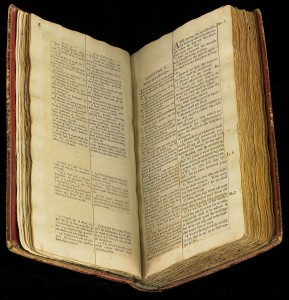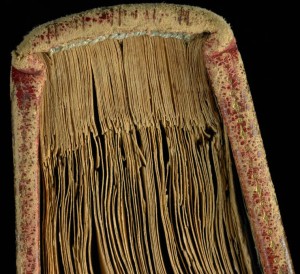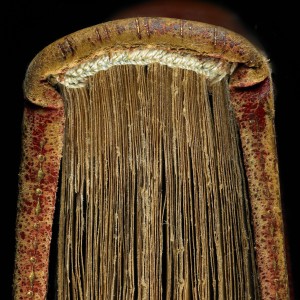 The conservation of the Jefferson Bible, aka The Life and Morals of Jesus of Nazareth, a philosophical re-editing of the New Testament Jefferson cut and pasted together from Bibles in four languages (English, French, Greek and Latin), is complete. Conservators from the Smithsonian’s National Museum of American History began the process in March after a detailed survey and laboratory tests determined that in order to keep the volume from falling apart, the pages would have to be removed, the binding altered and all the damage repaired before the book was put back together and kept in oxygen-free storage for the rest of its days.
The conservation of the Jefferson Bible, aka The Life and Morals of Jesus of Nazareth, a philosophical re-editing of the New Testament Jefferson cut and pasted together from Bibles in four languages (English, French, Greek and Latin), is complete. Conservators from the Smithsonian’s National Museum of American History began the process in March after a detailed survey and laboratory tests determined that in order to keep the volume from falling apart, the pages would have to be removed, the binding altered and all the damage repaired before the book was put back together and kept in oxygen-free storage for the rest of its days.
 The binding was the main cause of deterioration. Jefferson’s bookbinder, Frederick Mayo glued stubs to Jefferson’s pages so that the paper would be as thick at the spine as it was in the center of the book where Jefferson had glued the cut-outs from his four source Bibles to the front and back of each page. Over time, the stiff paper of those stubs caused thousands of tears to the pages. In order to ensure the book could be stabilized, opened and closed, put on display, the stubs had to be removed permanently and the damaged pages repaired as gently as possible. All the original materials of the binding — the Moroccan red leather cover, the paper liners, even the silk endbands where the pages meet the leather in the spine — were preserved so the book could be put back together after the repairs.
The binding was the main cause of deterioration. Jefferson’s bookbinder, Frederick Mayo glued stubs to Jefferson’s pages so that the paper would be as thick at the spine as it was in the center of the book where Jefferson had glued the cut-outs from his four source Bibles to the front and back of each page. Over time, the stiff paper of those stubs caused thousands of tears to the pages. In order to ensure the book could be stabilized, opened and closed, put on display, the stubs had to be removed permanently and the damaged pages repaired as gently as possible. All the original materials of the binding — the Moroccan red leather cover, the paper liners, even the silk endbands where the pages meet the leather in the spine — were preserved so the book could be put back together after the repairs.
 It took conservators seven hours just to remove the leather cover. The next day they cut the sewing threads that bound Jefferson’s 43 folios together into one book. Every page was repaired with care to ensuring the least amount of modification. There was no attempt to make the book look new or freshly restored. The sole aim was to repair damage and stop the deterioration. The original stubs were removed intact and preserved separately. Since the book still needs fillers at the spine to make up for the thick scrapbook pages, conservators created new ones out of Japanese kozo fiber paper, an acid-free, soft but exceptionally strong tissue paper with excellent aging properties. The kozo stubs provide the necessary fullness without the friction and pulling of the original stubs.
It took conservators seven hours just to remove the leather cover. The next day they cut the sewing threads that bound Jefferson’s 43 folios together into one book. Every page was repaired with care to ensuring the least amount of modification. There was no attempt to make the book look new or freshly restored. The sole aim was to repair damage and stop the deterioration. The original stubs were removed intact and preserved separately. Since the book still needs fillers at the spine to make up for the thick scrapbook pages, conservators created new ones out of Japanese kozo fiber paper, an acid-free, soft but exceptionally strong tissue paper with excellent aging properties. The kozo stubs provide the necessary fullness without the friction and pulling of the original stubs.
Kozo paper was also used to repair tears and cracks in the pages. Conservators applied the tissue paper to a torn area with conservation quality adhesives (all of them reversible should future conservators need to undo what was done). Each mend along the edges that had kozo paper overlapping the page was cut with a scalpel through a microscope to ensure that it followed the exact line of the original jagged-edged paper.
Once the pages were repaired but still separated in their original folios, they were photographed at high resolution. These are the first color pictures ever taken of the entire Bible.
Finally, the pages were resewn together through the original Frederick Mayo sewing holes. The original silk endbands were sewn back on the spine and finally the original leather cover reattached. The result is a Jefferson Bible that looks almost identical to the original but that can now be opened and the pages turned without tearing the whole thing apart.
The Jefferson Bible is on display at the National Museum of American History until May 28th, 2012. Those high resolution pictures taken of the pages before rebinding have been put to outstanding use: the entire Jefferson Bible is now online.
If you’re interested in learning more about how the Bible was repaired (and you are because it’s fascinating), I highly recommend the step-by-step slideshow of the conservation process on the new Jefferson Bible website. For a more detailed examination of some of the challenges conservator’s faced, see the National Museum of American History’s blog series documenting the conservation:
1. A peek inside the conservation of the Jefferson Bible,
2. What can we learn from the gutter of Jefferson’s bible?
3. Unlocking the mysteries of Jefferson’s bible with high-tech analysis and microscopic testing,
4. Unbinding the Jefferson Bible,
5. Treating the Jefferson Bible
Look for a sixth and final entry, probably in the new year.